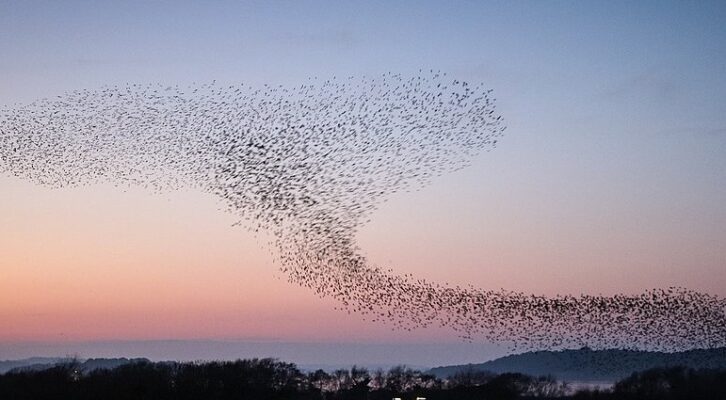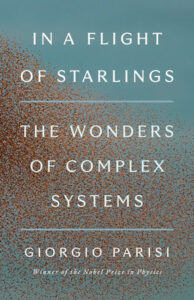
From One Into Many: On the Science of Starling Murmurations
Giorgio Parisi Considers Practical Applications of Theoretical Physics
The question of interaction is a crucial one in many areas, including for the purposes of understanding certain psychological, social, and economic phenomena. The work described in this essay focuses on how each member of a flock of birds is able to communicate in order to move in a coherent way, producing a single entity that is at once collective and multiform.
It is fascinating to observe the collective behavior of animals, be it that of flocks of birds, shoals of fish, or herds of mammals. At sunset we can see starlings forming fantastic patterns, thousands of milling black specks against the changing colors of the sky. We witness them all moving in unison, without touching or dispersing—avoiding obstacles, moving apart and coming together again, continuously reconfiguring their spatial arrangement, almost as if an orchestra conductor were giving order to everything that is happening. We could watch these birds endlessly, because the show they put on is perpetually altered and renewed, taking different and unexpected forms.
When confronted with all this beauty, the professional curiosity of a scientist cannot but be piqued; wheels begin to turn and questions form. Is there really something like a conductor at work behind this collective behavior, or is it self-organized? How can information be transmitted so rapidly throughout the flock? How is it possible that the shapes made by the collective can change so quickly? How are the different speeds and acceleration rates of the birds distributed within the murmuration? How can they maneuver together without bumping into each other? Might there be simple rules of interaction between starlings that account for such complex and variable collective movements as the ones we see in the skies?
When we are curious and want to know the answers to certain questions, we begin by looking for them in existing research: previously in books, nowadays online. If we are lucky, we find the answers. But when there is no answer to be found because no one has fathomed it yet, and if we are truly curious, we begin to wonder if we might be the ones to uncover it. The fact that no one else has succeeded is scarcely off-putting. This, after all, is the scientist’s calling: to imagine or to do what no one has done before.
But we cannot spend our lives attempting to open locked doors that no one has a key to. Before beginning, it is crucial to understand whether or not we have the competence, technical skills, and tools that will allow us to accomplish the job. Even then, nobody has any guarantee of success. We have to throw ourselves headlong into the task and aim high. Still, if the target is so high that we have no chance of reaching it, then it’s better not to begin.
When there is no answer to be found because no one has fathomed it yet.
The flocking of starlings held a particular fascination for me, because it was connected by a common thread not only to my research but to so many other studies in modern physics that attempt to understand the behavior of systems composed of a large number of interacting components or actors. In physics, depending on the context, the actors can be electrons, atoms, spins, or molecules. These actors may have very simple rules of behavior that when taken together give rise to much more complex collective behavior.
Beginning in the nineteenth century, statistical physics attempted to respond to questions related to and arising from such interaction. Questions such as why a liquid boils or freezes at certain temperatures, or why certain substances (such as metals) are good conductors of electric current and heat, whereas others are insulators. The answers to some of these questions were found over time. We continue to look for the answers to others.
In all such physics problems, we try to understand quantitatively how collective behavior emerges from simple rules governing the interaction between individual actors. The challenge here is to extend the applicability of statistical mechanics techniques from inanimate entities to living animals such as our starlings. The results would be of interest not only to ethology and evolutionary biology but might also, in the longer run, lead to a greater understanding of economic and social phenomena. In these cases too we are dealing with great numbers of individuals who influence each other. In general we often need to understand the connection between the behavior of single individuals and collective behavior.
The great American physicist Philip Warren Anderson, a Nobel Prize winner in 1977, expounded this idea in his provocative 1972 article “More Is Different,” maintaining that an increase in the number of components in a system creates a change that is not just quantitative but qualitative. The main conceptual problem facing physics was to understand the relationship between microscopic rules and macroscopic behavior, in a great variety of different systems. Anderson played a key role in the development of complexity theory, and we will come across him again in a later chapter.
In order to explain something, we must first know about it, and in this case we were lacking key data. We needed to understand the spatial movements of flocks, but this information was unavailable at the time. In fact, the enormous quantity of video footage and photographs that was available (and that can now be easily found on the internet) was all taken from a single point of view or camera angle, and was therefore devoid of three-dimensional information. In this respect we were like the prisoners in Plato’s cave, who could see only the two-dimensional shadows of things projected on the walls of their prison, but not the three-dimensional aspects of the objects that made them.
It was precisely this difficulty that made the study of the movement of starlings so interesting for me: it was a complete project in itself. It involved designing the experiment, collecting and analyzing data, developing computer modeling for simulations, and interpreting the experimental results.
We knew that the methods of statistical physics, which have always been my field of research, would be indispensable for the three-dimensional reconstruction of the movements of the birds, but the thing that really attracted me was the planning and realization of the experimental part of the project. We theoretical physicists usually work at a distance from the laboratory, with abstract concepts.
Solving a real problem involves keeping a large number of variables under control—ranging, in this case, from the resolution of the focal lengths of camera lenses to the optimal positioning of the cameras, and from data storage capacity to data analysis techniques. Each element can affect the success or failure of the experiment, and when you plan at your desk (or on the training ground), you have no idea how many problems will occur in the field, or out on the pitch. Which is why I never liked being too far from the lab.
Starlings are extremely interesting birds. Centuries ago, they spent the warmer months of the year in northern Europe and wintered in North Africa. Today winter temperatures are higher due to climate change, and our cities have also become much warmer—partly on account of their growth in size, partly due to the increase in sources of heat, such as central heating and traffic. Many starlings no longer cross the Mediterranean, overwintering instead in various coastal Italian cities, including Rome, where winters are much milder than they used to be.
__________________________________

Excerpted from In a Flight of Starlings: The Wonders of Complex Systems by Giorgio Parisi. Copyright © 2023. Available from Penguin Press, an imprint of the Penguin Publishing Group, a division of Penguin Random House, LLC.
Giorgio Parisi
Giorgio Parisi is an Italian theoretical physicist and professor of theoretical physics at the Sapienza University of Rome. Together with Klaus Hasselmann and Syukuro Manabe, he received the 2021 Nobel Prize in Physics.



















